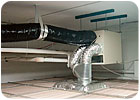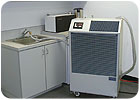
A 12-ton portable a/c unit was called in to cool a large computer room. Portables are often sourced as a substitute to provide close to, or exactly, the same Btu capacity, said Garth Tagge, vice president of sales, Spot Coolers Inc.
Times are changing, though.
As the market for portable air conditioners has evolved, so have the applications requirements, said Garth Tagge, vice president of sales at Spot Coolers Inc. No longer viewed as merely a “band aid” during a/c outages, portables are often specified to provide equivalent cooling capability to that of the installed system, he said.
“In essence, portables are often sourced as a substitute to provide close to, or exactly, the same Btu capacity,” said Tagge. “These needs can be for short-term outages of a day or two, such as during a/c failures or service intervals, or for longer-term requirements, which can extend a month or more.”
In other words, no longer used as merely a stopgap measure, temporary cooling should become a viable tool in the contractors’ and engineers’ arsenal, he said.
“Expect new and different equipment to become designed and available as this market segment continues to expand,” said Tagge.
WATER-COOLED SOLUTIONS
Right now, the easiest and often most effective way to provide exact cooling capacity is with water-cooled equipment. Water-cooled units can provide reliable and efficient cooling capacity with minimal setup requirements. They are manufactured in 1-ton to 5-ton capacities. The 1- and 1-1/2-ton units are made in 110 V configurations. According to Tagge, most 2-ton to 5-ton models are offered in 208 V or 460 V configurations.“Water-cooled units can operate down to low ambient requirements, typically to 60°F or lower,” said Tagge. “Most water-cooled units have a slim profile as well, due to the elimination of the condenser fan, motor, and scroll assembly. This makes them desirable in tight spaces or in places where floor space is at a premium.”
Most water-cooled units can be rented or purchased with temporary hose kits. These come in varying lengths and can be hooked up to sinks or other hose connections for water supply. The heated waste water can be dumped back into the sink, into another drain, or piped back into a condenser water line or cooling tower. For permanent cooling requirements, units can be permanently piped into a water supply, condenser line, or cooling tower.
Because water-cooled equipment utilizes only one fan and motor (evaporator), current draws are low compared to air-cooled equipment, said Tagge.
“Lower electric use is considered an advantage for water-cooled equipment and many people may choose water-cooled when availability of power is limited,” he explained.
However, water-cooled equipment requires a significant water supply. When using “once through” water supplies - like city water - often only short-term requirements are considered.
“Water-cooled units don’t come in large capacity,” said Tagge. “When considerably more than 5 tons of capacity is required, water-cooled units may not be feasible.”
In addition, many IT managers are skeptical of using temporarily plumbed water-cooled equipment in computer or other equipment rooms, he said. The devastation a water line break or leak would cause often leads them to another type of a/c equipment, he added.

Pictured is a rack-mounted spot cooler in a computer server room. A unit can be installed within the standard server rack, saving space, and directing the air closer to the heat source – the server equipment.
ENGINEERED AIR-COOLED SOLUTIONS
When significant Btu capacity is required, the call usually goes out to air-cooled units. Jobs requiring a localized 15 tons or more often aren’t feasible with water-cooled units, said Tagge.“A very popular unit, often used when big capacity is required, is the 12-ton cart-mounted air conditioner,” he explained. “This unit has many features which lends itself to large space cooling or during the repair or replacement of Liebert and other computer grade a/c units of 15 tons or more. Even though these units are air cooled, they have been designed for large scale cooling in hospitals, office buildings, and other commercial and institutional buildings.”
In Tagge’s estimation, the 12-ton unit is very compact for its capacity. Not quite small enough to fit through a standard 2-foot, 6-inch wide door, it can be loaded on almost any freight elevator and rolled down most hallways. Units are placed outside the suite or equipment room to be cooled and duct hoses are used to supply and return the air to and from the unit.
“The 12-ton unit utilizes high static fans on both sides,” explained Tagge. “These fans can deliver air long distances from both the evaporator and condenser coils. Both 14 inch evaporator supply ducts can be extended 100 feet to deliver air, while the two 14 inch returns can also be ducted 100 feet to pull the air back to the unit.
“In this way, a 12-ton unit placed in the hallway can deliver and return its evaporator air well within the typical office suite or equipment room.”

Relatively new to the market are ceiling-mounted units, which can be converted to either portable or rack-mounted units. Pictured above is a 1-ton unit above the ceiling. These units can bring flexibility to the portable a/c arena.
When equipment must be placed inside the space to be cooled, smaller air-cooled units can be utilized. “Makeup air requirements can be met by installing makeup air plenums on the condenser intake,” explained Tagge. “These cover the condenser coil and have a duct connection to affix the ductwork.”
Outfitted in this way, he said units could both draw and reject condenser air into the hallway, out a window, etc. Much like installed units, these kits maintain “neutral pressure” and make them efficient for both temporary and permanent solutions “where it is desirable to maintain and control room temperatures,” he said.
“These air-cooled portables are available in up to 7.5 tons in capacity. As with water-cooled units, 1- and 1-1/2-ton units are available in 110 V power supplies. Most 2-ton to 7.5-ton units come in either 208 V or 460 V configurations.”

Shown is a 3-ton water-cooled portable air conditioner with a sink hookup. For permanent cooling requirements, units can be permanently piped into a water supply, condenser line, or cooling tower.
CEILING-MOUNTED CONVERTIBLES
Relatively new to the market are ceiling-mounted units which can be converted to either portables or rack-mounted units. Most popular in small server rooms, these units can be used in a variety of applications and bring flexibility to the portable air conditioning arena. Different accessory packages allow for the transformation from permanently mounted to portable configuration.“When permanent mounting overhead is desirable, a ceiling kit is specified along with the unit,” said Tagge.
“The ceiling kit includes the hardware and plenums needed to mount the unit overhead, within the drop ceiling space. Ducting and a plenum attached to the evaporator provides the cold supply air into the room and the return air from within the space. A remote thermostat is included to provide control.
“A condensate pump is included to handle the waste water. Condenser air is channeled away from the unit with another plenum attachment and gets pulled back into the building air system. Installed in this manner, the unit provides space cooling and temperature control.”
Another option is the rack-mounted kit. According to Tagge, this allows the unit to be installed within the standard server rack, saving space, and directing the air closer to the heat source - the server equipment. A rack kit includes the hardware and plenums needed to attach the unit and direct both the cold and hot air.
“The final option is the portable kit, which consists of wheels, ducts, and plenums,” he said.
“A collection tank or pump can handle the condensate. This makes this compact unit a portable and even has a provision to stack up to 3 units one on top of the other when additional capacity is required, saving floor space.”
At this point, these units only come in a 10,000 Btu capacity, said Tagge. However, new models are planned as the concept gains wider acceptance.
Sidebar: Sizing Metrics
In the eyes of Garth Tagge, determining how much cooling (and which models to use) for a temporary or emergency application is not dissimilar to performing standard load calculations.The vice president of sales at Spot Coolers Inc., said a space that needs 10 tons of permanently installed air conditioning to provide adequate cooling will need approximately the same amount of “engineered” temporary cooling.
“Any significant adjustments to your standard load calculations usually occur when you are sizing for computer or equipment room applications versus comfort cooling applications or when the environment to comfort cool consists of many enclosed spaces,” said Tagge.
When providing comfort cooling, the biggest impediment to achieving temperature control is providing optimal air distribution throughout the space, explained Tagge.
“This is particularly true when the space is broken up with walls, offices, or cubicles deflecting the airflow,” he said. “Wide-open space is much easier to cool and allows for the use of larger capacity equipment.”
According to Tagge, significantly demised space usually requires the use of more equipment in smaller capacities (“placed in smaller demised spaces such as individual offices”) in lieu of, or in addition to, larger tonnage units, such as the 12 ton, to provide enough airflow throughout the entire area.
“Computers and other heat-generating equipment reject sensible heat,” explained Tagge. “In order to adequately cool an equipment room or provide some supplemental cooling for any a/c equipment that has been shut down or is being replaced, sensible cooling is required.
“When sizing a computer or equipment room, calculate the tonnage needed to replace the cooling that is missing and multiply that tonnage by 125 percent to determine that actual tonnage you will need to provide. This takes into account the fact that nearly all portable air conditioning units provide approximately 75 percent sensible cooling Btu.”
Publication date:07/09/2007
